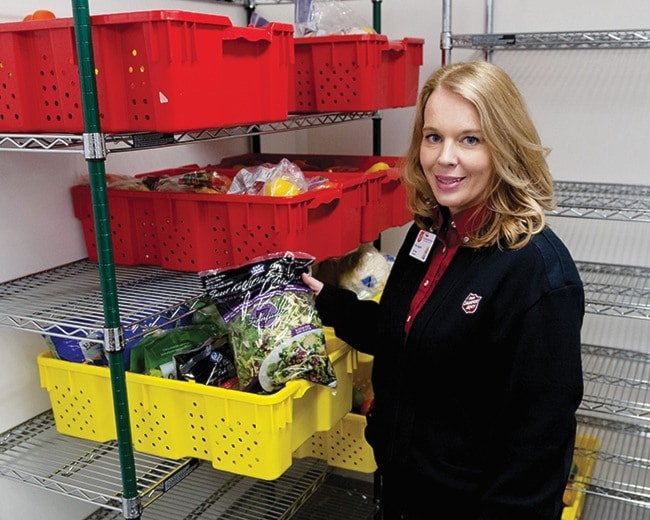Thrifty Foods manager Bill Rutledge had often been asked by customers why his store's discarded produce could not instead be given to the Salvation Army's Food Bank.
Thanks to the efforts of food bank co-ordinator Trina Jiggins, he no longer has to answer those questions.
The food bank earlier this year unveiled its Healthy Choices program, which supplements clients' usual non-perishable food choices with selections of fresh produce and dairy items from Parksville's Thrifty Foods and other donors.
"We had always heard we couldn't do it here at this location because we didn't have space for it," said Jiggins. "I was of the mentality, let's make the room; let's do it."
After getting quotes of $25,000 and more for a commercial walk-in cooler, Jiggins saw a homemade cooler at a local organic farm and began researching the possibility of doing the same thing on a larger scale. So, utilizing a 24,000-btu air-conditioning unit, special CoolBot thermostat, and partially donated lumber and labour, the Salvation Army constructed a 21-by-12-foot walk-in cooler in the back of the food bank's garage.
The cooler allows the food bank to accept donations from Thrifty Foods and individuals of perishable products that are nearing their best-before sell date but that Food Bank Canada approves for consumption up to a week afterward.
A similar food repurposing program has been running through Nanaimo's Loaves and Fishes, but this is the first time perishables have been distributed at the Parksville Qualicum Food Bank.
"We've had customers ask questions about why we don't do this in Parksville," said Rutledge. "I said, 'Well, that has nothing to do with me; I would love to do it but there's things that have to happen first. Then Trina really got on board with getting the cooler space and getting it all organized."
Jiggins, who actually approached Rutledge about a partnership before the cooler was built, said the store manager was on board immediately.
"It was unbelievable. I made one call and they said, 'Yes, we'll do it,'" Jiggins said of her "negotiations" with the store, a member of the Sobey's chain. "For them, it's all about community support. I went in for a meeting, they helped us get the contracts mailed out, and we were up and running probably three weeks after I first contacted them."
The Salvation Army provides bins, which are colour-coded for different days of the week, and picks up the produce and other items from Thrifty Foods each morning.
"It's a perfect reciprocal relationship," Thrifty produce manager Shayne Peterson said. "Anything we don't want to put on our shelves, that we feel they might be able to use or consume going forward, we relegate to Salvation Army. That's food that never would have made it to someone's plate before."
Rutledge said the program is redirecting up to two tons of food per week that previously would have gone to compost.
"I don't think that healthy eating should be a luxury for people," said Jiggins. "I go home and I have carrots and broccoli and salad, and I think people that are struggling should be able to, too."
The local food bank is set up in a unique grocery store style. Instead of simply getting a bag of pre-packaged food, clients are given "points" depending on their allowance and can shop the shelves for their own choices. After completing a loop of the shelves, they arrive at the fresh produce section where they are allowed to take as much as they can use of that day's offerings.
"When we first started using the food bank there was very little in the way of fresh produce," said one client, a mother of two young children. I was actually reluctant to go to the food bank in the first place because even though I was struggling financially, I was worried the quality of food would be too low. When they started bringing in organic milk, organic kefir, and a whole array of fresh vegetables, including things like organic arugula and more sprouts, I was thrilled. These are the foods I would buy if I could afford them."
Dwight Holland, a homeless outreach worker with the Canadian Mental Health Association, said his clients have shared numerous positive comments about the increased options at the food bank.
"Many people, especially those with chronic health issues, if they can eat better they feel better," said Holland. "And this makes fresh food more available, particularly for people who would otherwise have a hard time affording it."
The fresh produce has also been incorporated into the food bank's sharing with the Ballenas Secondary School breakfast program, the SOS preschool lunch program and the soup kitchen, said Jiggins. Partially spoiled produce can be cut up, with the good parts used in soup and other recipes and the bad portions donated to a pig farm.
"It's not just staying at the food bank, but helping out the whole community," said Jiggins. "I wanted to get Thrifty's a thank-you card, but there's not a big enough thank-you card that I could get for them. I wanted to relay that to them because it's changing people's lives. It really is."
